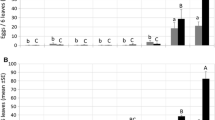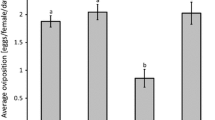Abstract
Plants with leaves having numerous trichomes or domatia frequently harbor greater numbers of phytoseiid mites than do plant with leaves that lack these structures. We tested the hypothesis that this pattern occurs, in part, with Typhlodromus pyri because trichomes increase the capture of pollen or fungal spores that serve as alternative food. Using a common garden orchard, we found that apple varieties with trichome-rich leaves had 2–3 times more pollen and fungal spores compared to varieties with trichome-sparse leaves. We also studied the effects of leaf trichome density and pollen augmentation on T. pyri abundance to test the hypothesis that leaf trichomes mediate pollen and fungal spore capture and retention and thereby influence phytoseiid numbers. Cattail pollen (Typha sp.) was applied weekly to mature ‘McIntosh’ and ‘Red Delicious’ trees grown in an orchard and, in a separate experiment, to potted trees of the same varieties. ‘McIntosh’ trees have leaves with many trichomes whereas leaves on the ‘Red Delicious’ trees have roughly half as many trichomes. With both field-grown and potted trees, adding cattail pollen to ‘Red Delicious’ trees increased T. pyri numbers compared to ‘Red Delicious’ trees without pollen augmentation. In contrast, cattail pollen augmentation had no effect on T. pyri populations on ‘McIntosh’ trees. Augmentation with cattail pollen most likely supplemented a lower supply of naturally available alternative food on ‘Red Delicous’ leaves and thereby enhanced predator abundance. These studies indicate that larger populations of T. pyri on pubescent plants are due, in part, to the increased capture and retention of pollen and fungal spores that serve as alternative foods.
Similar content being viewed by others
References
Addison J.A., Hardman J.M. and Walde S.J. 2000. Pollen availability for predaceous mites on apple: spatial and temporal heterogeneity. Exp. Appl. Acarol. 24: 1–18.
Chamberlain A.C. 1975. The movement of plant particles in plant communities. In: Monteith J.L. (ed.), Vegetation and the Atmosphere. Academic Press, New York, pp. 155–204.
Chant D.A. 1959. Phytoseiid mites (Acarina: Phytoseiidae). Part I. Bionomics of seven species in southeastern England. Can. Entomol. 91 Suppl. 12: 5–44.
Downing R.S. and Moilliet T.K. 1967. Relative densities of predaceous and phytophagous mites on three varieties of apple trees. Can. Entomol. 99: 738–741.
Duso C. and Camporese P. 1991. Developmental times and oviposition rates of predatory mites Typhlodromus pyri and Amblyseius andersoni (Acari: Phytoseiidae) reared on different foods. Exp. Appl. Acarol. 13: 117–128.
Duso C. and Vettorazzo E. 1999. Mite population dynamics on different grape varieties with or without phytoseiids released (Acari: Phytoseiidae). Exp. Appl. Acarol. 23: 741–763.
Grafton-Cardwell E.E. and Ouyang Y. 1995. Augmentation of Euseius tularensis (Acari: Phytoseiidae) in citrus. Ann. Entomol. Soc. Am. 24: 738–747.
Grafton-Cardwell E.E., Ouyang Y.L. and Bugg R.L. 1999. Leguminous cover crops to enhance population development of Euseius tularensis (Acari: Phytoseiidae) in citrus. Biol. Control 16: 73–80.
Grostal P. and O'Dowd D.J. 1994. Plants, mites and mutualism: leaf domatia and the abundance and reproduction of mites on Viburnum tinus (Caprifoliaceae). Oecologia 97: 308–315.
Karban R., English-Loeb G., Walker M.A. and Thaler J. 1995. Abundance of phytoseiid mites on Vitis species: effects of leaf hairs, domatia, prey abundance and plant phylogeny. Exp. Appl. Acarol. 19: 189–197.
Kennett C.E., Flaherty D.L. and Hoffmann R.W. 1979. Effect of wind-borne pollens in the population dynamics of Amblyseius hibisci (Acari: Phytoseiidae). Entomophaga 24: 83–98.
McMurtry J.A. and Croft B.A. 1997. Life-styles of phytoseiid mites and their roles in biological control. Annu. Rev. Entomol. 42: 291–321.
McMurtry J.A. and Johnson H.G. 1965. Some factors influencing the abundance of the predaceous mite Amblyseius hibisci in Southern California (Acarina: Phytoseiidae). Ann. Entomol. Soc. Am. 58: 49–56.
Norton A., English-Loeb G. and Belden E. 2001. Host plant manipulation of natural enemies: Leaf domatia protect beneficial mites from insect predators. Oecologia 126: 535–542.
Nyrop J.P., English-Loeb G. and Roda A.L. 1998. Conservation biological control of spider mites in perennial cropping systems. In: Barbosa P. (ed.), Conservation of Natural Enemies of Pests. Academic Press, New York, pp. 307–33.
Ouyang Y., Grafton-Cardwell E.E. and Bugg L.L. 1992. Effects of various pollens on development, survivorship and reproduction of Euseius lularensis (Acari: Phytoseiidae). Environ. Entomol. 21: 1371–1376.
Overmeer W.P.J. 1981. Alternative prey and other food resources. In: Helle W. and Sabelis M.W. (eds), Spider Mites. Their Biology, Natural Enemies and Control. Elsevier, Amsterdam, pp. 131–140.
Overmeer W.P.J. and van Zon A.Q. 1984. The preference of Amblyseius potentillae (Garman) (Acarina: Phytoseiidae) for certain plant substrates. In: Griffiths D.A. and Bowman C. (eds), Acarology VI. Horwood, Chichester, pp. 591–596.
Rasmy A.H. and El-Banhawy E.M. 1974. Behaviour and bionomics of the predatory mite, Phytoseius plumifer (Acarina: Phytoseiidae) as affected by physical surface features of host plants. Entomophaga 19: 255–257.
Roda A.L., Nyrop J.P., Dicke M. and English-Loeb G. 2000. Trichomes and spider mite webbing protect predatory mite eggs from intraguild predation. Oecologia. 125: 428–435.
Roda A., Nyrop J., English-Loeb G. and Dicke M. 2001. Leaf pubescence nad two-spotted spider mite webbing influence phytoseiid behavior and population density. Oecologia 129: 551–560.
StataCorp. 1999. Stata Statistical Software: Release 6.0. Stata Corporation, College Station.
Tanigoshi L.K., Mégevand B. and Yaninek J.S. 1993. Non-prey food for subsistence of Amblyseius idaeus (Acari: Phytoseiidae) on cassava in Africa. Exp. Appl. Acarol. 17: 91–96.
Tauber H. 1967. Investigations of the mode of pollen transfer in forested areas. Rev. Palaeobotan. Palynol. 3: 277–286.
von Engel R. and Ohnesorge B. 1994a. Die Rolle von Ersatznahrung und Mikroklima im System Typhlodromus pyri Scheuten (Acari, Phytoseiidae)-Panonychus ulmi Koch (Acari, Tetranychidae) auf Weinreben. I. Untersuchungen im Labor. J. App. Ent. 118: 129–150.
von Engel R. and Ohnesorge B. 1994b. Die Rolle von Ersatznahrung und Mikroklima im System Typhlodromus pyri Scheuten (Acari, Phytoseiidae)-Panonychus ulmi Koch (Acari, Tetranychidae) auf Weinreben. II. Freilandversuche. J. App. Ent. 118: 224–238.
Walde S.J., Nyrop J.P. and Hardman J.M. 1992. Dynamics of Panonychus ulmi and Typhlodromus pyri: factors contributing to persistence. Exp. Appl. Acarol. 14: 261–291.
Walter D.E. 1996. Living on leaves: mites, tomenta, and leaf domatia. Annu. Rev. Entomol. 41: 101–114.
Wei Q.C. and Walde S.J. 1997. The functional response of Typhlodromus pyri to its prey, Panonychus ulmi: the effect of pollen. Exp. Appl. Acarol. 21: 677–684.
Yue B. and Tsai J.H. 1996. Development, survivorship, and reproduction of Amblyseius largoensis (Acari: Phytoseiidae) on selected plant pollens and temperatures. Environ. Entomol. 25: 488–494.
Author information
Authors and Affiliations
Corresponding author
Rights and permissions
About this article
Cite this article
Roda, A., Nyrop, J. & English-Loeb, G. Leaf pubescence mediates the abundance of non-prey food and the density of the predatory mite Typhlodromus pyri . Exp Appl Acarol 29, 193–211 (2003). https://doi.org/10.1023/A:1025874722092
Issue Date:
DOI: https://doi.org/10.1023/A:1025874722092




